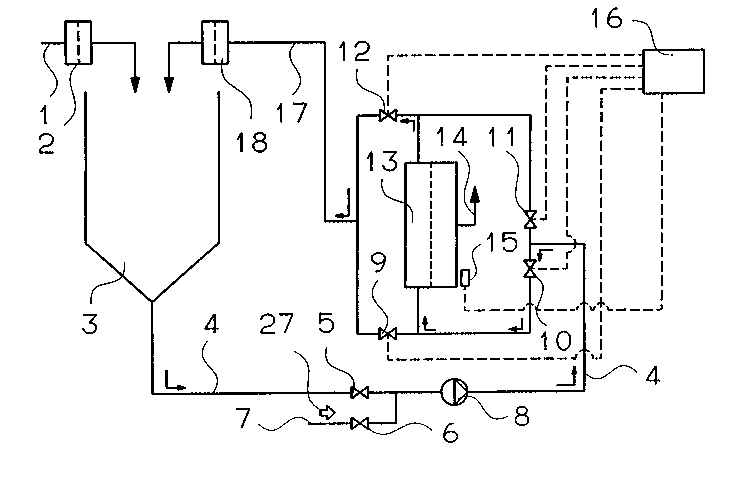Some of the information on this Web page has been provided by external sources. The Government of Canada is not responsible for the accuracy, reliability or currency of the information supplied by external sources. Users wishing to rely upon this information should consult directly with the source of the information. Content provided by external sources is not subject to official languages, privacy and accessibility requirements.
Any discrepancies in the text and image of the Claims and Abstract are due to differing posting times. Text of the Claims and Abstract are posted:
| (12) Patent Application: | (11) CA 2141846 |
|---|---|
| (54) English Title: | PROCESS FOR CLEANING THE FILTER MODULES OF A PLANT FOR PURIFYING LIQUIDS |
| (54) French Title: | PROCEDE POUR LE NETTOYAGE DE FILTRES MODULAIRES UTILISES DANS UNE INSTALLATION D'EPURATION DE LIQUIDES |
| Status: | Deemed Abandoned and Beyond the Period of Reinstatement - Pending Response to Notice of Disregarded Communication |
| (51) International Patent Classification (IPC): |
|
|---|---|
| (72) Inventors : |
|
| (73) Owners : |
|
| (71) Applicants : | |
| (74) Agent: | OSLER, HOSKIN & HARCOURT LLP |
| (74) Associate agent: | |
| (45) Issued: | |
| (86) PCT Filing Date: | 1994-06-02 |
| (87) Open to Public Inspection: | 1994-12-22 |
| Availability of licence: | N/A |
| Dedicated to the Public: | N/A |
| (25) Language of filing: | English |
| Patent Cooperation Treaty (PCT): | Yes |
|---|---|
| (86) PCT Filing Number: | PCT/CH1994/000103 |
| (87) International Publication Number: | WO 1994029007 |
| (85) National Entry: | 1995-02-06 |
| (30) Application Priority Data: | ||||||
|---|---|---|---|---|---|---|
|
ABSTRACT
The process for cleaning the filtration modules (13)
of a cross-current filtration apparatus is carried out in a
system which is employed to clarify liquids, particularly
those with a high proportion of fiber. A problem in this
respect is the continuous accumulation of fibers, especially
at the entry to the filtration modules (13) at the face ends
of the various conduits, which can cause plugging. To
reduce the accumulations of fiber, when cleaning is done the
flow direction in the module (13) is reversed, compared with
the preceding filtration cycle. This is done by suitably
switching valves (9-12). Because of the reversal of the
flow direction flow cleaning, the fiber accumulations can be
easily detached while still small and flushed out of the
modules. Plugging up of the modules can thus be averted.
Le procédé de nettoyage des modules de filtration (11) d'un dispositif de filtration à courant transversal est exécuté dans une installation servant à la décantation de liquides, en particulier ceux contenant une proportion élevée de fibres. L'accumulation continue de fibres pose des problèmes en pareil cas, principalement à l'entrée des modules de filtration (13) placés aux extrémités avant des canaux, accumulation qui peut conduire à des obturations. Pour détruire les accumulations de fibres, on inverse, pendant le nettoyage, le sens de l'écoulement dans le module (13) par rapport au cycle de filtration précédent. Cette action est opérée par l'enclenchement des vannes (9 à 12). L'inversion du sens d'écoulement pendant le nettoyage permet de dissoudre facilement les accumulations de fibres demeurées peu importantes et de les évacuer à l'extérieur des modules. On peut ainsi éviter l'obturation de ces modules.
Note: Claims are shown in the official language in which they were submitted.
Note: Descriptions are shown in the official language in which they were submitted.

2024-08-01:As part of the Next Generation Patents (NGP) transition, the Canadian Patents Database (CPD) now contains a more detailed Event History, which replicates the Event Log of our new back-office solution.
Please note that "Inactive:" events refers to events no longer in use in our new back-office solution.
For a clearer understanding of the status of the application/patent presented on this page, the site Disclaimer , as well as the definitions for Patent , Event History , Maintenance Fee and Payment History should be consulted.
| Description | Date |
|---|---|
| Time Limit for Reversal Expired | 1997-06-02 |
| Application Not Reinstated by Deadline | 1997-06-02 |
| Deemed Abandoned - Failure to Respond to Maintenance Fee Notice | 1996-06-03 |
| Application Published (Open to Public Inspection) | 1994-12-22 |
| Abandonment Date | Reason | Reinstatement Date |
|---|---|---|
| 1996-06-03 |
Note: Records showing the ownership history in alphabetical order.
| Current Owners on Record |
|---|
| BUCHER-GUYER AG MASCHINENFABRIK |
| Past Owners on Record |
|---|
| EDUARD HARTMANN |